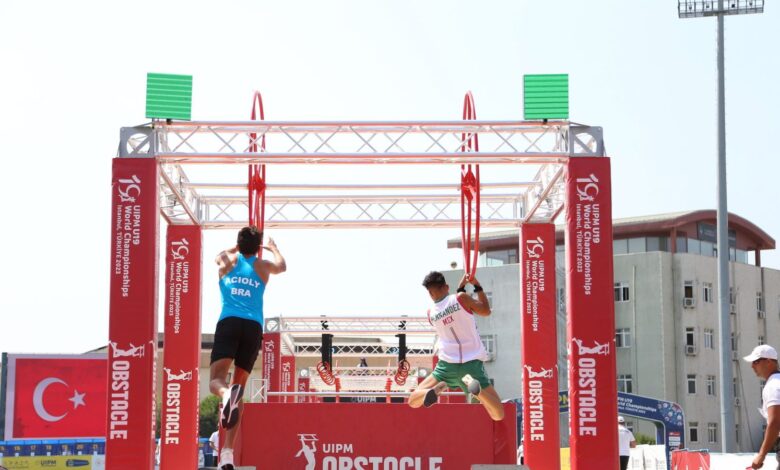Ninja-style obstacle course is how (Modern) Pentathlon will be different at Los Angeles 2028 – and why it will become more accessible | Sport-others News

Real horses will stop galloping and the Live carousels at the Olympics’ most emotive event – the modern pentathlon, will come to a halt, as Los Angeles saunters into focus.69 of 83 voting members of the sport’s governing body UIPM, chose to move on from show jumping, one of the five constituents of the pentathlon, and opt for an obstacle course, as the name ‘Modern’ was expected to be dropped. As the five rings appeared atop the HOLLYWOOD signage, it was expected that sporting entertainment would nudge out 1912 vintage horse jumps.
The thinking is that not everyone starts out at posh pony clubs, but almost everyone knows a jungle gym.
The cavalry fashionably went out of vogue against the stunning backdrop of the Palace of Versailles at the modern pentathlon event of the Paris Olympics last week. The show-jumping element of the five-event sport, which got scrunched from 5 days to a single day to now 90 minutes, will get dropped as the sport undergoes a revamp.
An obstacle course will replace the doomed horses’ event. The head-to-head sprint obstacle race is heavily influenced the sports entertainment TV hit Ninja Warriors, based on the Japanese series Sasuke, and other adventure racing variants that are quite a hit in the UK, America and Australia.
Modern Pentathlon Federation of India’s founding president Namdeo Shirgaonkar, who completed his tenure with the sporting body before 2023 but remains closely interested in its development, has ordered obstacle equipment, looking ahead to the future. “We are thinking of setting it up at Pune’s Balewadi stadium on a testing basis. But the emphasis will be on making a permanent facility at Goa, where we conducted the event partially last year and got a very good response. The sport suddenly opens up to ordinary people, and that’s why there’s optimism,” Shirgaonkar explained.
Modern pentathlon has forever been seen as too elit, and “European”, but largely skewed in favour of nations with a strong base in riding stables – restricting it to Egypt, Mexico outside the top league. “Rich countries sort of held a monopoly on modern pentathlon because the horse element always naturally excluded those that didn’t grow up riding. The reason why horses got voted out was because a sport can’t be a preserve of the rich. The obstacle course democratises an elite sport,” he says. “You can’t ignore that the Ninja show is a big rage amongst youth,” he added.
The Indian body saw an immediate opportunity because the mandated obstacle course could be set up at a large-ish venue for a fraction of what it took to stay up to date with the horse-on-the-rampway routine. “You put in just 10-20 lakh, and the obstacle part becomes accessible to many, unlike the horse bit that always was prohibitive. We have plans to do a talent hunt and training course after following testing events that have happened across the world in the U22 category,” he informed.
The horses came with multiple issues. Not only was there a direct advantage for pony club societies like Australia, Ireland, UK and even Egypt, but the event at the Olympics was riddled with troubles. Unlike Equestrian events, horses are assigned on the spot to the participants who get just 20 minutes to strike a working partnership and bond with the beasts.
At Paris, French Marie Oteiza’s hopes went up in smoke when her horse, Babouchka de la Bride refused a fence and threw her off. Another horse Dollar US D’Eckly got Spaniard Laura Heredia eliminated after three refusals. An animal cruelty scandal had wrecked Tokyo Games, involving a whipped horse a German coach, but tears were shed when bidding adieu to Versailles.
“See, horses are moody creatures. You never know when they suddenly get scared or bored. In pentathlon because they are assigned on the spot, you can’t even prepare for them,” Shirgaonkar said of situations like Babouchka de la Bride, who refused to run. “But you need to be a proficient rider prepared for this situation. That always kept many away from the sport and all my years in Modern Pentathlon, Indians would get wary of the sport, and run away from it because costs were a put-off.”
The sport itself was cloyingly attached to tradition, riffed off as inspired from a comprehensive skill-set of perfect soldiers. The idea is a tad archaic, because cavalries hardly get involved in modern warfare, unless scouting out unreachable mountainous regions. The 3 km Laser Run with a short course race, interspersed with target shooting, also further dialled down on the military-themed simulations, as standard non-firearm laser guns, massively reduced costs and made traveling safer. The easing out of horses replaced obstacles, keeps the focus on fitness, but makes the sport less clunky, logics-wise. Also less dependent on moody horses.
Ahmed Elgendy of Egypt who won gold had told UIPM, “We need to believe in the future of the sport. So I support the new movement.” Tamara Vega of Mexico was quoted UIPM as saying, “Pentathlon changed my life, and now the sport is changing its own life. The future of Pentathlon depends on this radical change.”
The obstacle course has charming elements like walls and ladders and giant rings and XL wheels, balance beams and a climb up Lisbon steps – more boot camp and elementary Seals, than 19th-century piecemeal combat chivalry of Knights and musketeers. As Shirgaonkar put it, “The Ninja show is a big influence, but it’s perfect because now anyone can get into the sport.”



